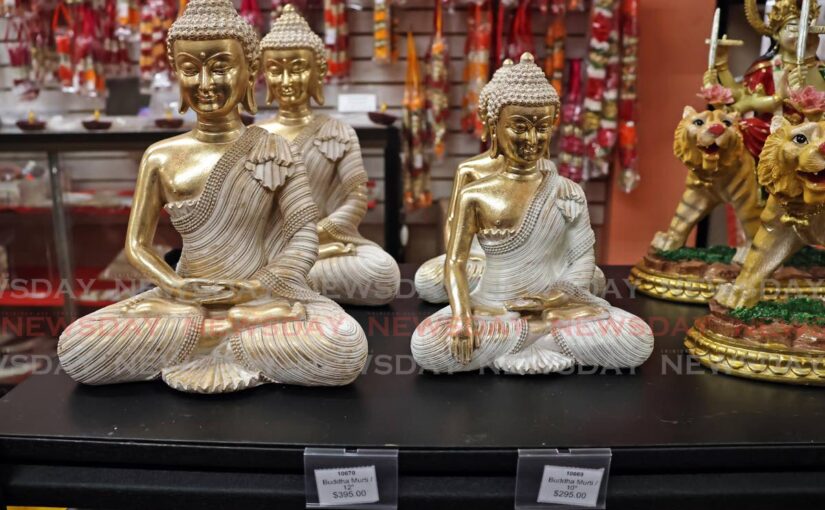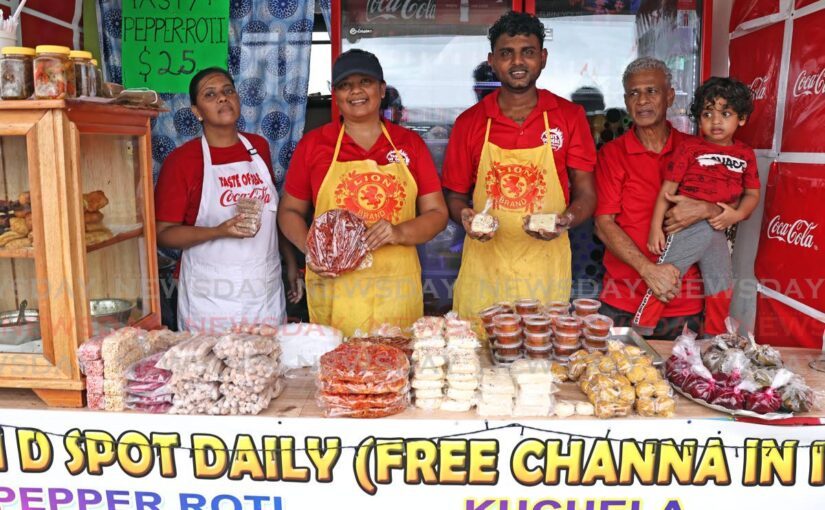BAVINA SOOKDEO THE puja store industry has blossomed into a niche yet essential business sector that caters to a range of religious and cultural...
Vous n'êtes pas connecté
- English
- Français
- عربي
- Español
- Deutsch
- Português
- русский язык
- Català
- Italiano
- Nederlands, Vlaams
- Norsk
- فارسی
- বাংলা
- اردو
- Azərbaycan dili
- Bahasa Indonesia
- Հայերեն
- Ελληνικά
- Bosanski jezik
- українська мова
- Íslenska
- Türkmen, Түркмен
- Türkçe
- Shqip
- Eesti keel
- magyar
- Қазақ тілі
- Kalaallisut ; kalaallit oqaasii
- Lietuvių kalba
- Latviešu valoda
- македонски јазик
- Монгол
- Bahasa Melayu ; بهاس ملايو
- ဗမာစာ
- Slovenščina
- тоҷикӣ ; toğikī ; تاجیکی
- ไทย
- O'zbek ; Ўзбек ; أۇزبېك
- Tiếng Việt
- ភាសាខ្មែរ
- རྫོང་ཁ
- Soomaaliga ; af Soomaali
Rubriques :
 Maroc - NEWSDAY.CO.TT - A la Une - 31/Oct 10:11
Maroc - NEWSDAY.CO.TT - A la Une - 31/Oct 10:11
The business of murti-making: Crafting devotion amid challenges
Murti-making, the craft of creating sacred statues representing Hindu deities (gods and goddesses) stands as a significant cultural and spiritual art form. Artisans like Dhanesh Kissoon of D Murtiman and Balliram Chan of Balliram’s Murtis and Crafts bring life to this tradition, blending creativity, devotion and skill into their work. Yet, this industry faces challenges ranging from competition with imported murtis to the complexities of sustaining a generational craft. For both craftsmen, the business is not something they inherited. “From a very young age I started to make cars, trucks and anything I saw out or clay from around the house” Kissoon told Business Day. “After finishing high school, I learnt how to do sculpting in Freeport at Mahase and Son Murti World, where I learnt how to fabricate and plaster different types of murtis using sand and cement. I was then inspired by Pundit Dave Rampersad to learn more about this artwork.” Chan explained that his inspiration was deeply encouraged by his late father Pundit Lackram Ramesh Chan, who was impressed when he saw his son’s drawings of deities. “One person showed me a few basic beginner steps and from there, I was self-taught through trial and error. Now I am advanced from where I began.” The demand for locally made murtis Despite an influx of imported murtis, according to Kissoon, the demand for locally crafted murtis remains strong, particularly during significant Hindu festivals like Divali and Ganesh Utsav. He stated that the demand peaks before Divali and during Ganesh Utsav when murtis are submerged into the water, necessitating fresh orders each year. Locally made murtis also allow customisation, which appeals to customers who want personal touches. “The demand for locally made murtis is growing every year because the imported murtis cost a lot more than locally made ones. My customers like to come and see how I make the murtis so if any changes are to be made, I can do it one time,” Kissoon explained, highlighting the personal connection between artisan and customer. Chan, however, said the murti-making industry has remained relatively static, with many opting to purchase imported murtis, often made from marble or stone. He noted the allure of high-end materials that can only be sourced abroad. Market saturated with imported murtis A pressing issue for local murti-makers is competition from imported murtis, which dominate the market and are readily available in most puja stores. “Yes, the market is saturated with murtis from India,” Kissoon said, adding that local artisans face challenges when puja stores import murtis from India, offering consumers immediate access to a variety of imported ones, often without the wait time associated with custom, handmade murtis. [caption id="attachment_1117863" align="alignnone" width="768"] A completed Ganesh murti made by Dhanesh Kissoon. - Photo courtesy Dhanesh Kissoon[/caption] Chan expressed a similar sentiment, stating that “imported murtis affect his business because concrete murtis (in which he specialises) are not in high demand,” and the limited interest in concrete murtis has a direct impact on his ability to grow his client base. Handcrafted versus moulded techniques The craftsmanship involved in murti-making varies between artisans. Both Kissoon and Chan use a combination of handcrafted techniques and moulds to meet different demands. Kissoon uses clay from pottery shops to make Ganesh murtis for Ganesh Utsav. But he mainly works with sand, cement and steel and creates most of his murtis by hand, though he sometimes employs a temporary mould to “speed up the work” when producing multiple pieces. On the other hand, Chan, who does concrete murtis, is dedicated to fully handcrafting his murtis, only occasionally using moulds for specific parts like faces, while still ensuring a personal touch. Even his moulds are handcrafted by him. Eco-friendly practices An emerging trend within murti-making is the shift toward eco-friendly practices, with an increasing preference for biodegradable materials, particularly for murtis used in rituals where immersion in water is required. Kissoon shared that he crafts Ganesh murtis from clay for Ganesh Utsav and uses eco-friendly water paint as these murtis are to be submerged. He disclosed too that every year he sees more customers ordering clay murtis for personal devotion. Chan, however, focuses on concrete for durability, given that his murtis are generally intended for long-term use. While not as biodegradable as clay, the concrete option appeals to temples and private homes where longevity is valued. A generational artform under threat Murti-making is often a generational art passed down through families, yet both artisans note a lack of interest from younger generations, posing a risk to the artform’s continuity. Kissoon observed that younger people “haven’t shown interest in this artwork,” largely due to the patience and concentration required. Chan echoed this concern, lamenting that “the older heads don’t want to pass down their knowledge,” which leaves little opportunity for apprenticeships and formal training. [caption id="attachment_1117862" align="alignnone" width="768"] A Ganesh murti made by Dhanesh Kissoon before it is painted. - Photo courtesy Dhanesh Kissoon[/caption] Efforts to preserve this artform remain minimal. Chan believes there is a need for “some sort of measure to showcase the artform,” suggesting that a platform for exhibitions could generate interest and awareness. He is willing to teach and share with anyone who is interested. For Kissoon too, passing down knowledge is essential, although he acknowledges that it may take some time before he can actively take on apprentices. Both Kissoon and Chan face various obstacles in sustaining their craft. Rising material costs, competition with imported murtis, and shifting consumer preferences are all ongoing concerns. Kissoon noted that customers often “shop around until they get what they can afford,” meaning that artisans must remain price competitive despite the increased costs of raw materials. Additionally, the demands of peak festival times can create logistical challenges, such as last-minute orders and material shortages. The local murti-making business is a blend of artistic expression, cultural preservation, and market dynamics. Artisans like Kissoon and Chan are striving to keep the craft alive, adapting where possible but remaining committed to their personal vision and cultural heritage. Chan hopes people will support the local craftsmanship and art form of murti-making as he said community support in preserving this vibrant yet vulnerable tradition is vital. The post The business of murti-making: Crafting devotion amid challenges appeared first on Trinidad and Tobago Newsday.
Articles similaires
Divali’s light: Handmade deyas still a top seller
Despite the prominence of newer technologies in the Festival of Lights, and an overall diminishing demand, traditional hand-crafted deyas remain...
Divali Nagar, a platform for up-and-coming entrepreneurs
The Divali Nagar is home not only to cultural expressions and celebrations but with at least 10,000 patrons nightly, it provides the perfect platform...
Samantha Seebalack adds touch of colour to Divali
Divali is the celebration of light over darkness, and artist Samantha Seebalack has been adding her own beauty to the Hindu festival of lights. In...
Graphene-enhanced 3D-printed concrete reduces carbon emissions by 31%
Researchers from the University of Virginia have made significant strides in the rapidly advancing field of 3D-printed concrete by developing a more...
Don seeks more funding for research institutes, policies to protect plants
A don, Prof. David Aworinde, has appealed to the Federal Government to put more funds in research institutes for further research in plants to make...
Hunters, Ochabrigade Rescue Kidnap Victim In Anambra
RAYMOND OZOJI, AwkaThe joint operation of the Nigerian Hunters and Forest Security Service (NHFSS) and the Operation Clean and Healthy Anambra...
Arshad Warsi Responds On His Comments Of Comparing Prabhas To “Joker”
Arshad Warsi Responds To Controversies Warsi post the Outburst of Backlash after he called ‘Prabhas’ a ‘Joker’. In his typical humorous style,...
The essential message of home
Dara E Healy Lakshmi karoti kalyasnam Aarogyam sukh sampsdam Mama shstru vinaashaaya Deep jyotir namostute Mother Lakshmi Grant me all round welfare...
The essential message of home
Dara E Healy Lakshmi karoti kalyasnam Aarogyam sukh sampsdam Mama shstru vinaashaaya Deep jyotir namostute Mother Lakshmi Grant me all round welfare...
Les derniers communiqués
-
Aucun élément








